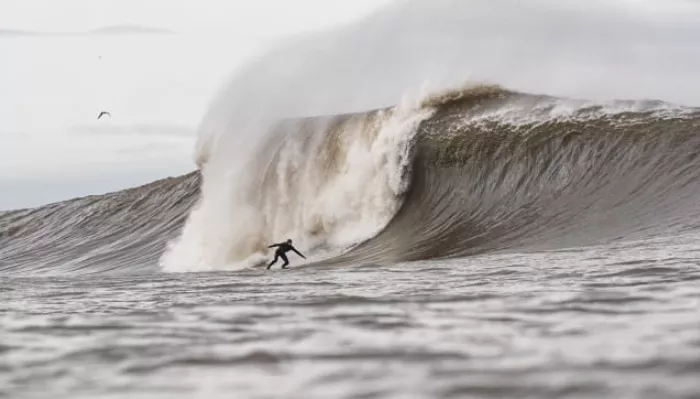The Big Sea explores the link between toxic neoprene production in Louisiana and rising cancer rates
A new documentary, The Big Sea, directed by British filmmakers Lewis Arnold, Chris Nelson, and Demi Taylor, is shedding light on the toxic environmental and health repercussions of neoprene wetsuit production. The film draws a direct connection between the production of neoprene in Louisiana and the alarming rise in cancer rates in nearby communities, particularly in St. John the Baptist Parish, an area commonly referred to as “Cancer Alley.”
St. John the Baptist Parish, located along the Mississippi River, has earned its grim nickname due to cancer risk rates that are 50 times higher than the national average. This high cancer rate has been attributed to decades of industrial activity, including the presence of multiple petrochemical plants. Among the most notorious is a neoprene manufacturing facility owned by Denka, a company the filmmakers argue is responsible for some of the area’s environmental and public health crises.
The Big Sea stands out as the first film to make the connection between neoprene production, used primarily in wetsuits, and the communities living in the shadow of these plants. “The Big Sea is a feature documentary about surfing’s connection to environmental racism,” said Arnold. “The link exists because surfing depends on chloroprene, a highly toxic substance used to make wetsuits. We’ve been surfers for years, and it wasn’t until recently that we learned about chloroprene’s dangers. We felt it was important to raise awareness about this issue.”
The film follows residents of St. John’s Parish, many of whom are descendants of formerly enslaved people who settled there after the Civil War. Over time, the area, once home to a tight-knit, historic community, has been transformed into what the Center for Health, Environment, and Justice calls a “sacrifice zone” — a region where industries are concentrated, and where communities, often marginalized, bear the brunt of toxic pollution.
Courtney Baloney, a third-generation undertaker whose family has long lived in the area, speaks in the film about the rise in cancer-related deaths. “I can eat organic all day long,” he says, “But if I’m walking outside just breathing in air, what can I do about that? Nothing. There’s nothing I can do except move away. Or fight the system.”
Neoprene, a form of synthetic rubber widely used in wetsuits, was first developed by chemical company DuPont. The primary ingredient in neoprene is chloroprene, a compound that, regardless of whether it is derived from oil or limestone, is toxic. Denka’s Louisiana plant is the largest producer of neoprene globally, producing material that is shipped to companies around the world for use in wetsuits.
In their investigation, The Big Sea filmmakers discovered that neoprene from Denka’s Louisiana plant continues to be a key component in wetsuits produced for many surf brands. “We found that shipments were still coming from Denka’s Louisiana plant,” said Chris Nelson. “Even if the neoprene comes from Japan, it’s still produced by Denka. We had to dig pretty deeply, but it was clear from the start.”
The Surf Industry Members Association (SIMA) has refuted the film’s claims, stating that wetsuit brands within their community do not source neoprene from Louisiana. “The production of wetsuits happens overseas, and companies are working with manufacturers like Sheico, Yamamoto, and Yulex to explore better options,” said Vipe Desai, SIMA’s executive director. He emphasized that the responsibility for the region’s pollution lies with the EPA, not the surf industry.
Despite industry pushback, many surf brands are beginning to embrace alternatives to traditional neoprene. Yulex, a natural rubber alternative, has been available for years, and with increased consumer demand, it could become the industry standard. Brands like Xcel and Patagonia have already made significant strides toward adopting Yulex, with Xcel committing to a full transition by 2027. Smaller companies like Wallien are also shifting entirely to Yulex, and French brand Oxbow has made the switch as well. Even Billabong, which has faced criticism for its opaque supply chain, has introduced a Yulex wetsuit line. This broader industry shift is gaining momentum, and it seems increasingly likely that the days of neoprene wetsuits may be numbered.
The film also critiques limestone-based neoprene, often marketed as an “eco-friendly” alternative. According to The Big Sea, limestone neoprene is no less harmful to the environment than the traditional oil-based version. The process of turning limestone into neoprene involves significant carbon emissions and environmental degradation, from the mining of limestone to its processing into rubber.
Dr. Sarah Gerhardt, a chemistry professor and big wave pioneer, makes a key point in the film: “It doesn’t matter which process you follow to get to chloroprene — chloroprene is chloroprene — chloroprene is chloroprene. It’s carcinogenic and highly reactive.”
Limestone quarries, too, contribute to environmental damage, including groundwater contamination and biodiversity loss, further exacerbating the ecological toll of neoprene production.
For the filmmakers behind The Big Sea, the solution is clear: the surf industry must move away from neoprene entirely. “For the sake of Louisiana’s communities, the climate, and our health, it’s time to find alternatives to these toxic materials,” said Arnold. The documentary has sparked conversations about environmental responsibility in the surf industry and beyond.
The Big Sea won Best Film at the London Surf Film Festival and will begin its UK and European tour in January 2025, with US and Australian dates to follow. As the film continues to raise awareness, it hopes to ignite a broader movement toward more sustainable and socially responsible practices in the surf industry.
Related topics
- Hayden Rodgers Wins Puerto Escondido After Pipeline Scare
- Lompoc Surf Shop Robbed, Suspect Arrested
- Is Surfing an Art Form? Stacy Peralta Believes It Is

